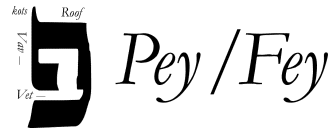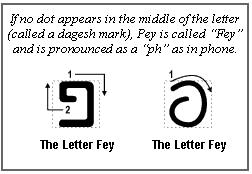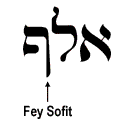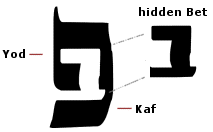|
|
 |
|
|
 |
 |
 |
|
- The Meaning of Pey
The word Peh ( ) means "mouth" and by extension, "word," "expression," "vocalization," "speech," and "breath." In the order of the Hebrew alphabet, Pey follows the letter 'Ayin, suggesting the priority of the eyes (i.e., understanding, awareness) before verbal expression (negatively, reversing this order results in "blind consumption" or mindless chatter). The chokhmah (wise one) is swift to observe and then to offer an opinion about something. 'Ayin gives insight, but it is the peh (mouth) that gives insight expression. ) means "mouth" and by extension, "word," "expression," "vocalization," "speech," and "breath." In the order of the Hebrew alphabet, Pey follows the letter 'Ayin, suggesting the priority of the eyes (i.e., understanding, awareness) before verbal expression (negatively, reversing this order results in "blind consumption" or mindless chatter). The chokhmah (wise one) is swift to observe and then to offer an opinion about something. 'Ayin gives insight, but it is the peh (mouth) that gives insight expression.
- The Mystery of Pey
Many kabbalists claim that the letter Pey is composed of two other letters: Kaf and Yod. Since one of the meanings of Kaf is "container" (i.e., spoon), it is suggested that the letter Pey is a picture of the divine spark (Yod) of God within the soul (Kaf, understood as a container for the soul).
Since peh (mouth) follows 'ayin (eye), certain Jewish mystics have maintained that though the 'ayin is the gateway to reality, the mouth is what brings reality into being. This is alluded to within the Scriptures, especially when God's creative activity (YHVH's Word) is considered. In fact, the Onkelos (a well-respected ancient Aramaic targum (translation) that dates back to the first century) rendered the phrase, nefesh chaiyah ("a living soul") as ruach memalla' ("a speaking spirit") in Genesis 2:7. God's speech creates reality, and since man is made b'tzelem Elohim (in the image of God), the sages reasoned that it was the power of speech and rationality that distinguished mankind from the lower animals that the LORD God created.
Since speech is related to memory, the sages have reasoned that the Hebrew word zachor ("remember") implies the vocalization of what was remembered. Thus the tradition of reciting Kiddush on Shabbat (based on Exodus 20:8) is explained, as is the custom of "remembering Amalek" by public recitation during the Torah reading liturgy.
- The Hidden Bet in Pey
The inner space of the letter Pey reveals the letter Bet. Since the first word of Scripture (bereshit) begins with an enlarged letter Bet (representing the house of creation), it is inferred that the invisible letter Pey (surrounding the Bet) represents the Word of God that created the heavens and the earth (Gen. 1:1; John 1:1-3). In other words, the very first letter of the Scriptures is a picture that the 'Word' of God is the agency behind the entire universe (Psalm 33:6).
A drash on the hidden Bet suggests that since Pey means mouth and Bet means home, what is spoken within the home is likewise spoken outside the home. In other words, our private conversation within our homes will reflect itself in our public life. Conversely, what we speak in public will also affect the quality of our life at home.
- The Gematria of Pey
The letter Pey represents the (ordinal) number 17 and the mispar (standard number) 80. The number 80 is the same value found in the words yesod (foundation) and gevurah (strength). This is also the age of Moses when he was called to lead the Children of Israel out of Egypt, and seems to be indicative of a sign of strength in human life
(Psalm 90:10).
- The Two Forms of Pey
The letter Pey has both a medial form ( ) and a sofit form ( ) and a sofit form ( ). The medial form is said to be "bent" in humility, suggestive of a "closed mouth." The sofit form, however, is said to be "open" and "upright." The midrash is that we must be silent and humble before we straighten ourselves to speak. If the mouth cannot bring forth praise and the truth of Torah, it should remained closed (Prov. 10:19). ). The medial form is said to be "bent" in humility, suggestive of a "closed mouth." The sofit form, however, is said to be "open" and "upright." The midrash is that we must be silent and humble before we straighten ourselves to speak. If the mouth cannot bring forth praise and the truth of Torah, it should remained closed (Prov. 10:19).
- The Midrash of Moses' Mouth
According to midrash (Shemot Rabbah 1:31), as a very young lad Moses was once seen throwing Pharaoh's gold crown down to the ground. Upon learning of this apparent act of insolence, Pharaoh devised a test to see if the child understood the implications of his actions. He therefore commanded that a platter with a piece of gold and a glowing piece of coal be brought before Moses and ordered the little boy to choose one. If Moses chose the gold, it would imply that he understood its value, and therefore he would be killed. On the other hand, if Moses chose the burning coal, he would be spared since he was unable to differentiate between gold and a glowing piece of coal.
Moses began to reach out for the gold when an angel pushed his hand aside and he grabbed the coal instead. Moses then immediately put his hand in his mouth, but that burned his lips and tongue so badly that he had a permanent speech impediment as a consequence.
Later, when God commissioned Moses to speak to the children of Israel, he protested to the LORD that he was kevad peh - "heavy of mouth" and kevad lashon, "heavy of tongue," and therefore unable to speak on behalf of the LORD (Ex. 4:10). God reminded him that He was the Creator of the mouth: "Who makes him mute, or deaf, or seeing, or blind? Is it not I, the LORD?" (Ex. 4:11). The LORD was then angry with Moses for his reluctance and decreed that "because of your words" he would not be permitted to be a kohen (priest), but his brother Aaron would.
Another midrash says that at age 80, Moses was given a "new mouth" to teach the people with, and yet another says that it was a sign to the Israelites in Egypt that Moses, the stutterer, could speak the divine Name perfectly when he stood before the people as God's mediator.
|
|














